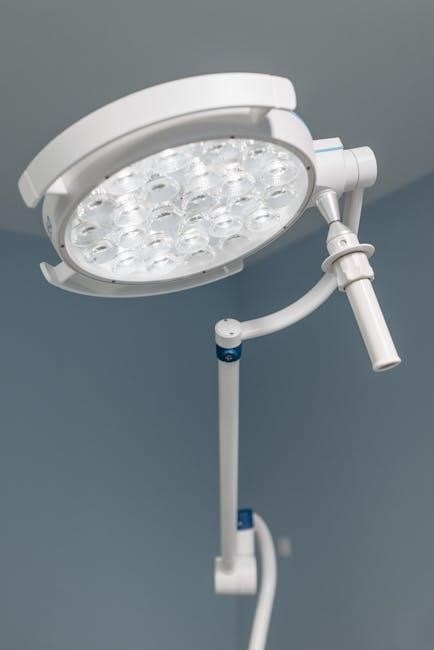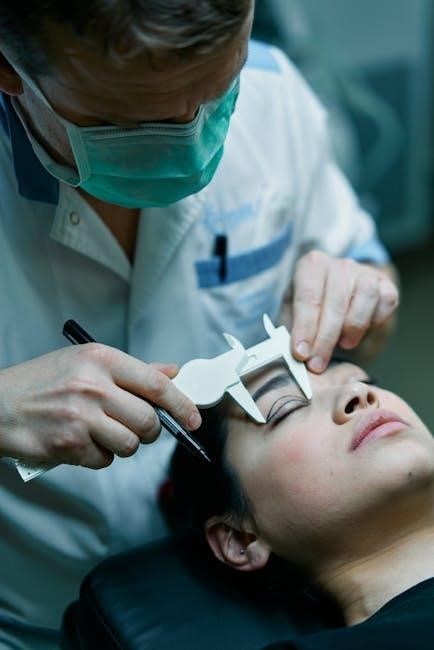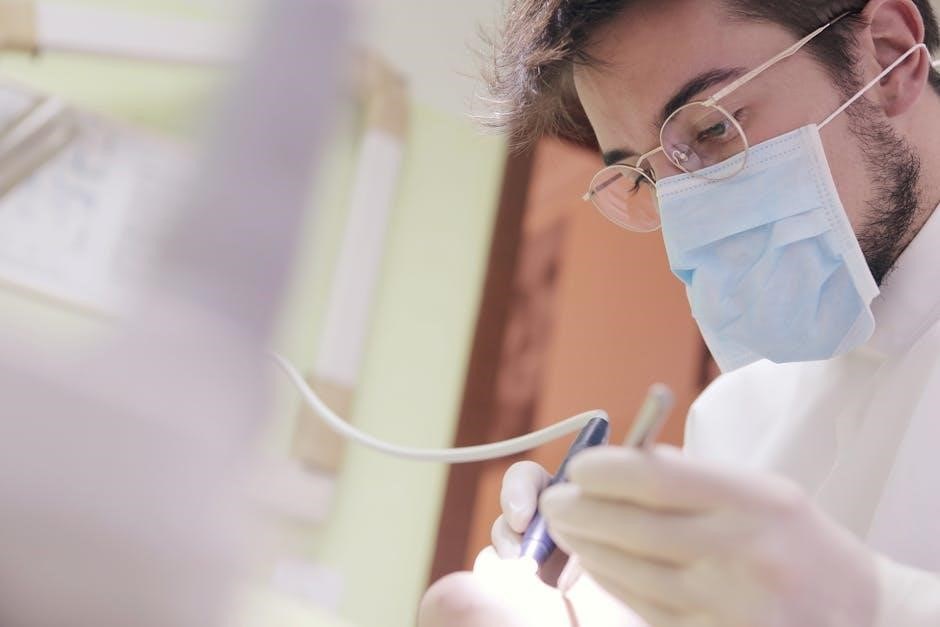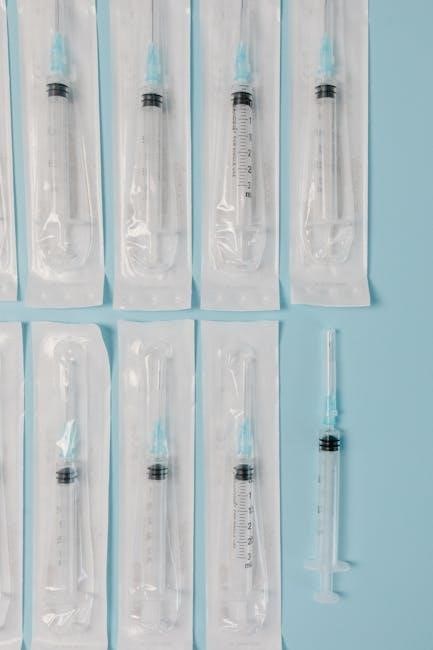Surgical sutures are essential tools in surgery and medicine, used for wound closure and tissue repair. They have a long history, evolving from materials like horsehair and silver wire to modern synthetic options. Their primary purpose is to approximate wound edges and support healing, with classifications based on absorbability, material origin, and structure. Understanding suture types and properties is crucial for effective wound management and surgical outcomes.
1.1 Definition and Purpose
Surgical sutures are medical devices used to close wounds, incisions, or repair tissue damage. They are designed to approximate tissue edges, promoting healing by maintaining tissue alignment. Sutures can be absorbable, degrading naturally in the body, or non-absorbable, requiring manual removal. Their primary purpose is to provide temporary or permanent structural support during the healing process, minimizing scar formation and restoring tissue integrity. Sutures play a critical role in surgeries and trauma care, ensuring proper wound closure and tissue repair.
1.2 Historical Evolution
The use of surgical sutures dates back to ancient civilizations, with early materials including horsehair, linen, and animal intestines. Egyptians and Greeks used needles and threads for wound closure. The Middle Ages saw the use of catgut, made from animal intestines. Modern advancements introduced synthetic materials like nylon and polypropylene, offering improved strength and reduced infection risks. Over time, sutures have evolved to meet specific surgical needs, enhancing patient outcomes and recovery. This evolution reflects ongoing innovation in medical technology.

Classification of Surgical Sutures
Surgical sutures are classified based on absorbability, material origin, filament structure, and coatings. They are categorized as absorbable or non-absorbable, natural or synthetic, monofilament or multifilament, and coated or uncoated.
2.1 Absorbable vs Non-Absorbable Sutures
A key classification of surgical sutures is based on their absorbability. Absorbable sutures, such as Vicryl and Monocryl, decompose naturally in the body, eliminating the need for removal. They are ideal for internal wounds or temporary support. Non-absorbable sutures, like Nylon and Prolene, remain intact and often require manual removal. They are commonly used for skin closure and provide long-term tissue support. The choice depends on the wound type, healing process, and surgical requirements.
2.2 Natural vs Synthetic Sutures
Natural sutures, such as silk and catgut, are derived from organic materials like animal tissues. They are often associated with higher tissue reactions. Synthetic sutures, including Nylon and Vicryl, are man-made polymers, offering consistent performance and reduced immune responses. Natural sutures are less predictable due to variability in source materials, while synthetic options provide uniform quality and tailored degradation rates, making them preferred for modern surgical applications.
2.3 Monofilament vs Multifilament Sutures
Monofilament sutures are made from a single strand, offering smooth passage through tissue and reduced risk of infection due to minimal surface area. Multifilament sutures, made from multiple strands braided or twisted together, provide greater strength and ease of handling but carry a higher risk of tissue reaction and infection. Monofilament sutures are preferred in delicate tissues, while multifilament sutures are often used for high-tension wounds, balancing strength and surgical needs.
2.4 Coated vs Uncoated Sutures
Coated sutures have a layer applied to reduce friction and improve tissue passage, minimizing trauma during insertion. Uncoated sutures, without such layers, offer better grip but can cause more tissue irritation. Coatings may be made of wax, silicone, or other materials, enhancing suture performance. Coated sutures are ideal for delicate tissues, while uncoated sutures are often used in general surgeries, balancing ease of use and tissue compatibility based on specific surgical requirements and preferences.
Types of Absorbable Sutures
Absorbable sutures, like Vicryl and Monocryl, are synthetic materials designed to degrade naturally in the body, eliminating the need for removal. They promote wound healing without long-term presence.
3.1 Vicryl (Polyglactin 910)
Vicryl, or polyglactin 910, is a widely used absorbable suture made from a copolymer of lactide and glycolide. It is known for its softness and is ideal for skin and soft tissue closure, particularly in sensitive areas like the perineum. Vicryl is also used in abdominal surgery for repairing gastrointestinal tract perforations and creating intestinal anastomoses. Its absorbable nature eliminates the need for removal, making it a preferred choice for surgeons in various procedures.
3.2 Monocryl (Poliglecaprone 25)
Monocryl, or poliglecaprone 25, is a synthetic, absorbable suture known for its smoothness and minimal tissue reaction. It is ideal for delicate tissues and skin closure, often used in plastic surgery due to its low inflammatory response. Monocryl is absorbed within approximately 100 days, providing sufficient strength during the healing process. Its monofilament structure ensures smooth passage through tissue, reducing the risk of infection and making it a preferred choice for surgeons in various procedures requiring absorbable sutures.
3.3 PDS (Polydioxanone)
PDS, or polydioxanone, is a synthetic, absorbable suture known for its extended strength retention. It maintains up to 50% of its tensile strength at 4 weeks and is completely absorbed within 180 to 240 days. PDS is ideal for tissues that require prolonged support, such as fascia, and is commonly used in general and pediatric surgery. Its monofilament structure reduces the risk of infection, making it a reliable choice for surgeons needing durable absorbable sutures in various medical procedures.
Types of Non-Absorbable Sutures
Non-absorbable sutures remain in the body indefinitely and are often removed manually. Common types include nylon, Prolene, and silk, each offering unique strength, flexibility, and durability for various surgical needs.
4.1 Nylon
Nylon sutures are non-absorbable, known for their high tensile strength and minimal tissue reaction. They are available in monofilament or multifilament forms, with monofilament offering smooth passage through tissue and resistance to infection. Nylon is durable and maintains knot security well, making it suitable for skin closure, general soft tissue, and ophthalmic procedures. Its flexibility and resistance to abrasion enhance its versatility in various surgical applications.
4.2 Prolene (Polypropylene)
Prolene, a non-absorbable monofilament suture made from polypropylene, is known for its smooth texture and high resistance to infection. It provides excellent knot security and minimal tissue reaction, making it ideal for cardiovascular and skin closure surgeries. Prolene’s durability and resistance to abrasion ensure long-lasting wound support. Its clear visibility and ease of handling make it a preferred choice for precise suturing in delicate tissues, offering reliable results in various surgical applications.
4.3 Silk
Silk, a natural non-absorbable suture, is valued for its softness and ease of handling. It provides minimal tissue irritation and excellent knot security. Silk sutures are often used for skin closures due to their smooth texture, reducing the risk of tissue damage. However, they can cause immune responses and are less durable compared to synthetic alternatives. Despite this, silk remains a popular choice for its tactile advantages and aesthetic outcomes in dermatological procedures.

Suture Techniques
Surgical suture techniques include simple interrupted, vertical mattress, and subcuticular methods. Each technique is chosen based on wound type, depth, and tissue requirements to ensure optimal healing.
5.1 Simple Interrupted Suture
The simple interrupted suture is the most commonly used technique in cutaneous surgery. It involves placing individual stitches with the needle entering and exiting the skin perpendicularly. This method provides precise wound closure with minimal tissue trauma, making it ideal for straight-line incisions. Each stitch is tied separately, allowing for easy adjustment and reducing the risk of tension. It is particularly effective for superficial wounds and is often the first technique taught to surgical trainees due to its simplicity and versatility.
5.2 Vertical Mattress Suture
The vertical mattress suture is a deep, penetrating stitch that provides strong closure for thick skin or fascia. It involves inserting the needle perpendicular to the skin, entering one side of the wound, exiting the other, and tying the knot. This technique ensures even distribution of tension and minimizes the risk of wound edges tearing. It is particularly effective for wounds under significant stress and is often used in procedures like cesarean sections. The vertical mattress suture promotes healing by maintaining tissue alignment and reducing scar formation.
5.3 Subcuticular Suture
The subcuticular suture is an intradermal stitch used for skin closure, minimizing visible scarring. It involves placing the suture thread just below the skin’s surface, parallel to the wound edges. This technique is ideal for delicate or cosmetically sensitive areas, such as the face or neck. The suture is typically absorbable, eliminating the need for removal. Subcuticular sutures reduce the risk of keloid or hypertrophic scarring and promote a smoother, more aesthetically pleasing healing process, making them a preferred choice in reconstructive and plastic surgery.

Specialized Sutures
Specialized sutures are designed for unique surgical needs, offering enhanced strength, reduced tissue reaction, or improved handling. They cater to specific procedures, optimizing outcomes in complex cases.
6.1 Retention Sutures
Retention sutures are large, strong sutures used to provide additional support in high-tension areas, such as fascia or thick tissue. They are typically non-absorbable and placed deeply to reinforce wound closure, reducing the risk of dehiscence. Often used in abdominal or thoracic surgeries, these sutures ensure the wound remains closed during the healing process, especially in cases where stress on the suture line is anticipated. They are crucial for preventing post-operative complications in complex surgical cases.
6.2 Barbed Sutures
Barbed sutures are innovative surgical tools featuring tiny barbs along the suture’s length, preventing loosening and promoting secure tissue approximation. Unlike traditional sutures, they eliminate the need for knots, reducing procedure time and minimizing tissue damage. Often used in laparoscopic and cosmetic surgeries, barbed sutures are particularly effective in delicate or hard-to-reach areas. They are available in both absorbable and non-absorbable materials, offering versatility for various surgical applications while maintaining strong wound closure and promoting healing.
